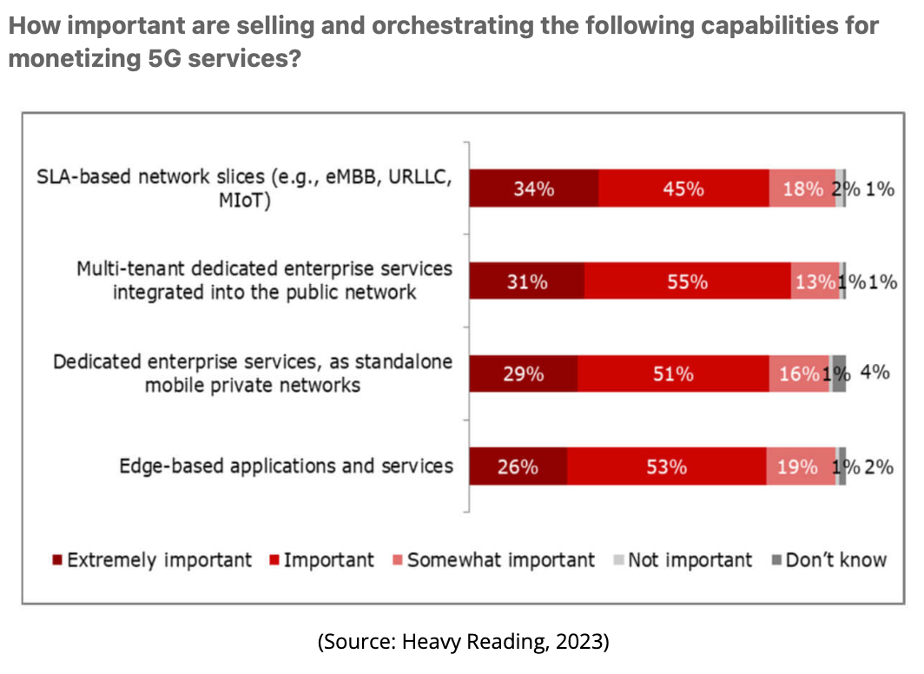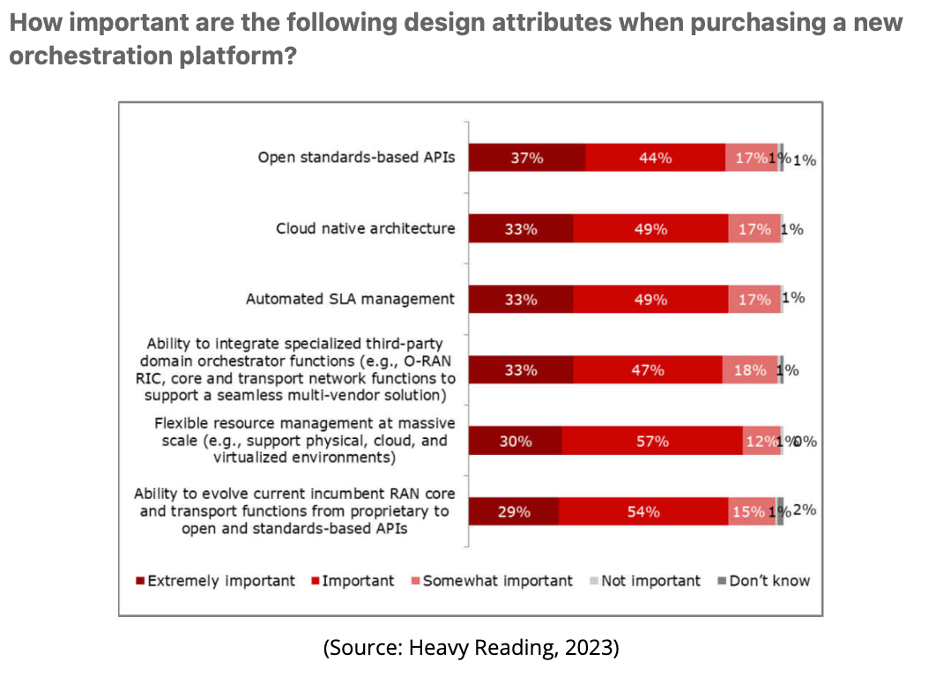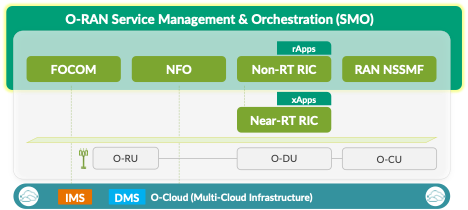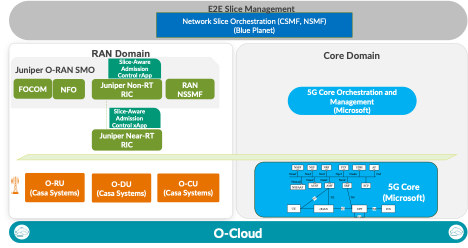The business landscape for new telecom services has never held so much potential for communication service providers (CSPs). With emerging 5G networks, CSPs can offer customizable network services for the first time, delivering end-to-end network slices tuned for specific use cases, applications, types of enterprises and even individual tenants. This means they can monetize their networks in new ways, launch new revenue models and reinvent their role in the digital ecosystem.
These trends are enormously exciting, however, CSPs must first overcome a long-standing challenge: legacy, closed and proprietary approaches to service management and orchestration that cannot meet the requirements of these new 5G services.
What’s wrong with traditional management solutions? They are general purpose and not designed to support open multivendor ecosystems (like O-RAN) or service-based management architectures, and they can’t meet the requirements of 5G network slicing. In the past, a CSP might provision a new service for a customer, and once deployed, that service could remain unchanged for years. But network slices are not static. Slices are spun up on demand, configured for changing application requirements and can have lifespans as short as a few hours. Network slices are often delivered under stringent SLAs, requiring automated closed-loop assurance. Also, the traditional management solutions are not designed with modern, open design principles or support for cloud-native microservices architectures. Traditional approaches to service management and orchestration are not built to realize end-to-end network slicing SLAs across RAN, Transport and Core network domains, each with a unique mix of technologies and standards.
What Do Service Providers Think?
To understand service provider priorities on 5G service orchestration, Juniper Networks and Heavy Reading conducted a survey with service providers on 5G Orchestration and Service Assurance.
There are two key takeaways from the survey findings:
- Orchestrating SLA based network slices is key to 5G monetization
- Support for Open, multivendor environments is a must-have for any orchestration platform
Orchestration Service Priorities
When asked to rank several 5G service options based on “extremely important” responses, SLA-based network slices led the way (34%). This result was followed closely by multi-tenant dedicated enterprise services integrated into the public network (31%), dedicated enterprise services as SA mobile private networks (29%) and edge-based applications and services (26%). This input confirms that successful orchestration strategies must be multifaceted and able to support end-to-end orchestration to facilitate a comprehensive view of a service as it traverses the edge, RAN, core, transport network and even cloud domains.

To meet or exceed the strict latency budgets of these premium offerings, service providers will have to develop new service-level agreements (SLAs) with their customers. In an orchestration context, 5G orchestrators must support the flexibility and programmability to meet these new demands.
Orchestration Platform Attributes
These flexibility demands will also affect the purchase criteria that service providers evaluate in making new orchestration platform purchasing decisions.
Based on “extremely important” input, 37% of respondents selected open standards-based APIs as the leading purchasing decision. Close behind were other open attributes, such as the ability to integrate specialized third-party domain orchestrators (33%) and the ability to evolve existing current RAN, core and transport functions to open and standards-based APIs (29%).
Other functions, such as flexible resource management (30%), cloud native architecture (33%) and automated SLA management (33%), are also important. To support end-to-end orchestration, 5G orchestrators must be open, cloud native and able to support automated processes, including automated SLAs.

Based on the results of the survey and the trends in the marketplace, CSPs need a fresh approach to service management, one designed to bridge the gap between modern software-driven architectures and the telco world.
The requirements for such an approach include:
- Open, multivendor environments
- On-demand, end-to-end orchestration to support network slicing and new multitenant business models
- Support for strict SLAs with closed-loop automation
- Flexible resource management at massive scales
- Cloud-native architectures and components
How Juniper Networks’ O-RAN Service Management and Orchestration (SMO) Addresses New Service Management Requirements
Juniper Networks O-RAN Service Management and Orchestration (O-RAN SMO), incubated at Juniper Beyond Labs, is designed from the ground up for highly dynamic, virtualized, cloud-native modern networks. It’s purpose-built for 5G network slicing, so CSPs can provision, manage and monetize custom network services on demand. O-RAN SMO implements the 3GPP-defined RAN Network Slice Subnet Management Function (RAN NSSMF) which manages the portion of the network slice that belongs to the RAN domain. It also includes Juniper RAN Intelligent Controller (RIC) which brings intelligence and programmability to the radio network. Juniper RIC includes the Non-Real-Time RIC and Near-RT-Time RIC with their associated rApps and xApps to control the RAN network functions, O-DU (O-RAN Distributed Unit) and O-CU (O-RAN Central Unit). Juniper’s O-RAN Service Management & Orchestration (SMO) supports standard interfaces such as 3GPP, O-RAN and TMF across the entire architecture.

Juniper O-RAN SMO also supports FOCOM and NFO functions. FOCOM (Federated O-Cloud Management and Orchestration) is responsible for managing the infrastructure (e.g., clouds, data centers, clusters, etc.) on which the networks are deployed. The Network Function Orchestrator (NFO) orchestrates the deployments of the O-RAN workloads such as O-DUs, O-CUs and Near-RT RIC. FOCOM and NFO communicate with two O-RAN-defined modules in the O-Cloud: Infrastructure Management Service (IMS) and Deployment Management Service (DMS).
Juniper’s Proof of Concept with Telefonica and Capgemini
Juniper worked with Capgemini and Telefonica to design and implement a proof-of-concept for an end-to-end network slicing solution entirely provisioned and managed from the cloud. Industry players, including Microsoft, Intel, Blue Planet and Casa Systems participated in the PoC. Microsoft hosted the orchestration functions in Azure and provided its 5G standalone (SA) core network; Intel provided on-prem servers for virtualized baseband. Blue Planet provided the end-to-end service orchestration, built to interact with orchestrators responsible for each domain including radio orchestration and control with Juniper’s O-RAN Service Management & Orchestration (SMO) and RAN Intelligent Controller (RIC) with Slice-Aware Admission Control x/rApps; and Casa Systems provided disaggregated 5G radio access network (RAN).

The PoC demonstrated that CSPs can create, manage and assure 5G network slices by in a multi-vendor, standards-based environment. CSPs can take full advantage of open and disaggregated RAN architectures and control complex multivendor RAN environments at massive scales. With an SMO designed for multitenant network slicing, CSPs will be able to support a range of new use cases, including private 5G, RAN sharing, MVNO and neutral host. They can offer Network Slicing as a Service (NSaaS), empowering customers and partners to create their own custom network services on demand.
Summary
Everything Juniper does starts with our “Experience- First Networking” philosophy—the principle that every aspect of a network should relentlessly focus on service experience. This philosophy extends to the CSP operations teams delivering those experiences, too. Juniper’s O-RAN Service Management Orchestration (SMO) is designed for openness and flexibility to address service provider priorities as per the Heavy Reading survey. Juniper SMO is purpose-built for network slicing to help CSPs confidently move ahead and implement end-to-end network slicing now.

























